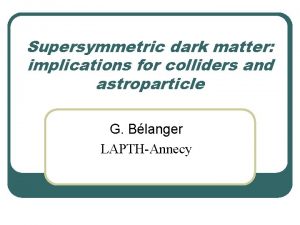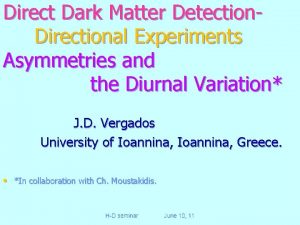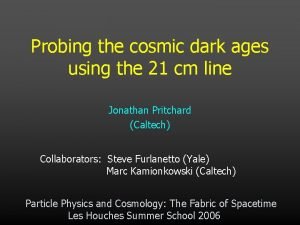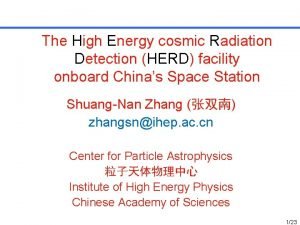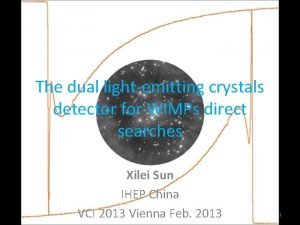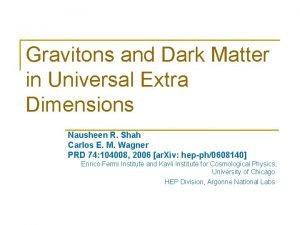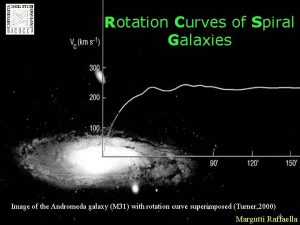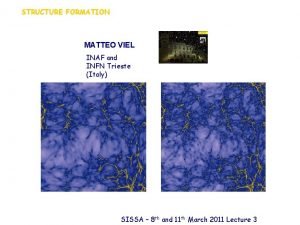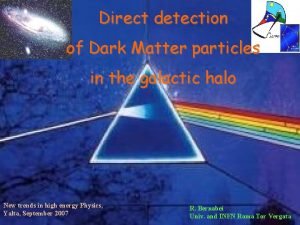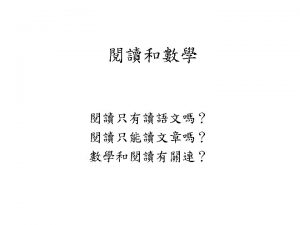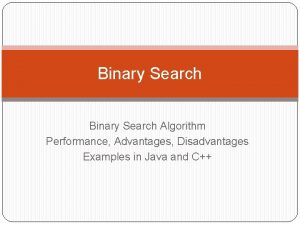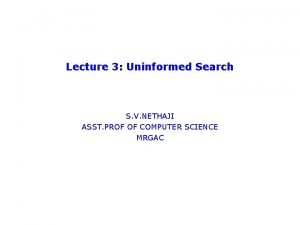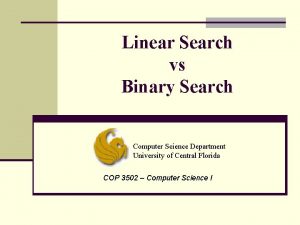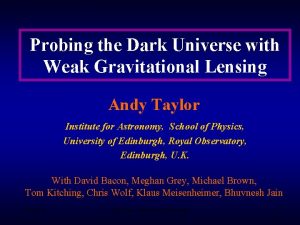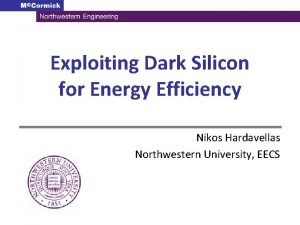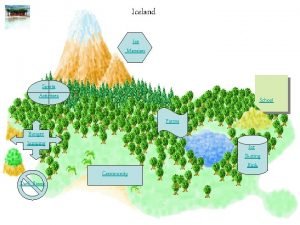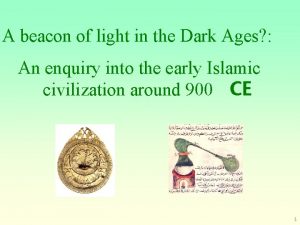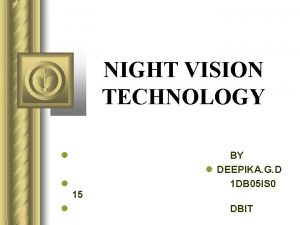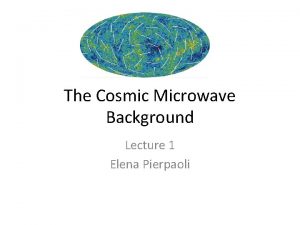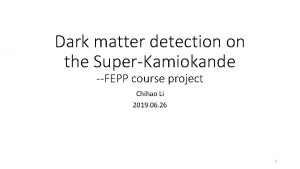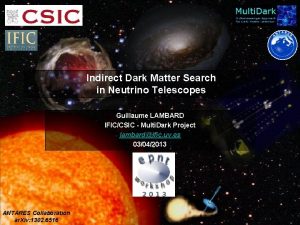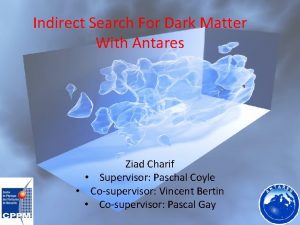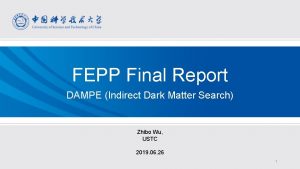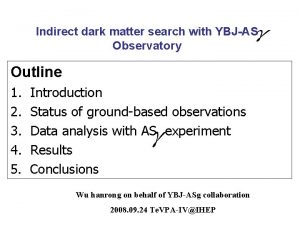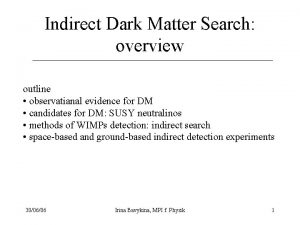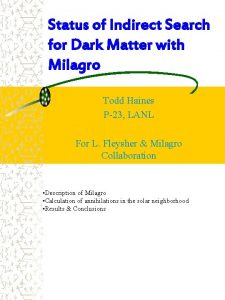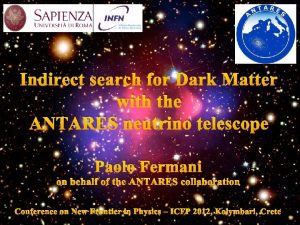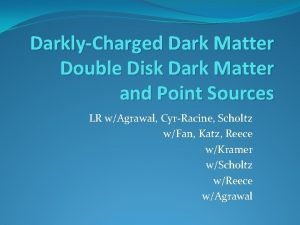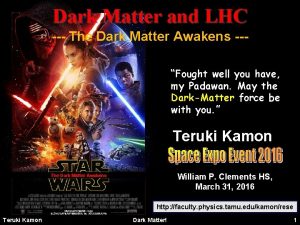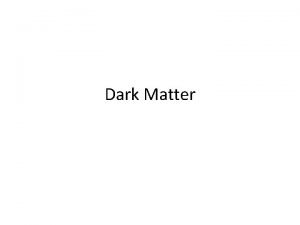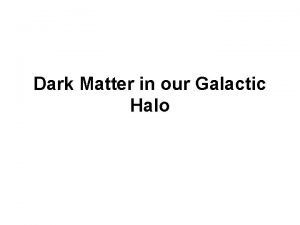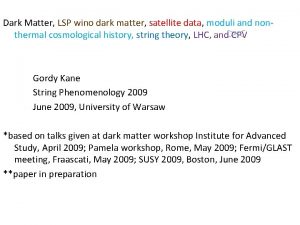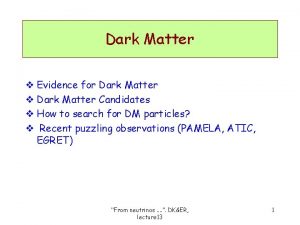Indirect dark matter search at SuperKamiokande Te V















































- Slides: 47

Indirect dark matter search at Super-Kamiokande Te. V Particle Astrophysics (Te. VPA 2016) CERN, 15 Sep. 2016 A. Takeda (ICRR, Univ. of Tokyo) for the Super-K collaboration 1

Experimental searches for dark matter particles Weakly interacting massive particles (WIMPs) are leading candidates for non-baryonic cold dark matter c collider time f time direct c time Indirect f WIMP searches are categorized in main three methods: l Hadron collider: using mono-jet and mono-photon signatures. l Direct: scattering interactions of WIMPs with nuclei in the detector. l Indirect: detection of the final products from WIMP annihilation. Possible target objects are Galactic Center, Milky Way halo, dwarf galaxies, and the Sun and the Earth. 2

Super-Kamiokande detector l The world largest pure water Cherenkov detector located in Kamioka mine (36 o 25’ N, 137 o 18’ E). l 50 kton pure water (22. 5 kton fiducial, 2 m from the walls of the inner detector) l 1, 000 m (2, 700 m w. e. ) underground l 11, 129 20 -inch PMTs in inner detector (ID) l 1, 885 8 -inch PMTs in outer detector (OD) Japan Kamioka Mine Many physics targets: l Neutrino oscillation: atmospheric n, solar n, T 2 K beam l Nucleon decay l Astrophysics: WIMP search, Supernova Relic Neutrino, Supernova burst, monopole search, etc. 3 Tokyo

Indirect WIMP search by Super-Kamiokande l The Sun: WIMP particles are scattered elastically and trapped in the deep solar core. Neutrinos produced by pair annihilation may be detected in terrestrial detector. l Galaxy: diffuse signal from entire Galaxy, peaked from Galactic center. The Sun scattering c pair annihilation c c n SK Neutrinos produced from decays of annihilation products are searched by Super-Kamiokande (*) The picture of Galaxy was taken from http: //www 2. nhk. or. jp/zero

(1) Solar WIMP search l Huge gravity allows enough captures to achieve equilibrium between capture and annihilation. l The capture process of WIMPs inside the Sun is same with direct detection. Typical neutrino energies are ~1/3– 1/2 of the WIMP mass or lower. SI interaction Super-K’s sensitivity to few-Ge. V neutrinos makes it suitable for ~10 Ge. V WIMP search and results are compared with direct detection on WIMP-nucleon elastic scattering cross section. Expected sensitivity of Super-K Kappl, R and Winkler, M. W. Nucl. Phys. B 850 (2011) 505

WIMP capture rate inside the Sun l Spin-dependent (SD) : main contribution comes from hydrogen. Owing to hydrogen-rich composition (~74% of total mass) of the Sun, high capture rate is expected. l Spin-independent (SI): Owing to coherent enhancement ∝A 2 and mass-matching factor, even small composition of heavy elements have large contribution to capture rate. (depends on solar composition model, then evaluation of uncertainty is important. It was considered in this analysis. ) The sensitivity for SI as well as SD for light WIMPs is expected to be competitive with direct detection Capture rate inside the Sun helium has largest value < 30 Ge. V Capture rate for SI coupling Oxygen has largest value > 30 Ge. V (SI) (SD) Kappl, R and Winkler, M. W. Nucl. Phys. B 850 (2011) 505 6 Zentner, A. R. , Phys. Rev. D 80 (2009) 063501

Data analysis l Real data: Accumulated during the SK I–IV run periods. l SK-I (1996– 2001), l SK-II (2002– 205, with half PMT coverage) l SK-III (2006– 2008) l SK-IV (2008– 2012 Mar. ) compared Live time [days] period FC + PC Upmu SK-I 1489 1646 SK-II 799 828 SK-III 518 636 SK-IV 1096. 7 Total 3902. 7 4206. 7 l MC simulation Generated for primary atmospheric neutrino flux was divided into below 2 samples (1) Atmospheric neutrino background: 250 -year MC sample per SK run period was normalized to the live time of each SK run period and oscillated (sin 2 q 13=0. 025, sin 2 q 12=0. 304, sin 2 q 23=0. 425, Dm 221=7. 66× 10 -5 e. V 2, Dm 232=2. 66× 10 -3 e. V 2) (2) WIMP neutrino signals: Other 250 -year MC sample per SK run period was reweighted by the ratio of WIMP neutrino flux to original atmospheric neutrino flux. WIMPSIM 3. 01 was used to simulate the neutrino flux from WIMP annihilation in the Sun at Super-K. (cc→t+t-/bb/W+W- channels from 4 to 200 Ge. V/c 2) 7

WIMP induced neutrino events at Super-K SK data (I–IV) l Example of reconstructed angle to the Sun (cosqsun) BG MC (normalized by live time) Signal MC (6 Ge. V/c 2 bb) and momentum distribution Signal MC (200 Ge. V/c 2 t+t-) (*) WIMP MC for bb and tt at 90% upper limit are magnified 30 times for visibility -> Excess neutrinos in the direction from the Sun were searched. 8

WIMP contribution by pulled c 2 method Data was fitted with “atmospheric neutrino + WIMP induced neutrino” to find best fit value of WIMP contribution : # of observed events in i-th bin : # of expected BG events : # of events of signal MC normalization parameter for WIMP signal 1 s value of j-th systematic uncertainty sj‘s pull sj‘s predicted fractional change of the # of BG (signal) events in the j-th bin due to 1 s change. l The data and MC calculations are distributed into 480 bins based on reconstructed momentum and cosqsun. l It makes full use of the energy, angle, and flavor information. 9

Conversion from flux limit to WIMP-nucleon scattering cross section limit Simulation package Dark. SUSY 5. 0. 6 was used for conversion l Capture/annihilation of WIMPs in the Sun l Propagation inside the Sun, vacuum, and inside the Earth considering oscillation and interaction Assumptions l WIMPs have only a single type of interaction with nucleus (SI or SD) l For SI interaction, 2 cases are considered: (1) isospin-invariant (coupling to neutrons (fn) = coupling to protons (fp)) (2) isospin-violating dark matter (IVDM) with destructive interference (fn/fp= -0. 7) l Standard DM halo (r=0. 3 Ge. V/cm 3, vrms=270 km/s, vsun=220 km/s) l Solar composition is based on BS 2005 -OP model. l Pair annihilation to fermion or boson with mono channel (bb, t+t-, W+W-) l Equilibrium between capture and annihilation 10

90% C. L. upper limits on the SD WIMPproton cross section Solid red line: 90% C. L. upper limit calculated at default Dark. SUSY. The shadowed red bands show consideration of uncertainties in the capture rate. Below 100 Ge. V/c 2, we set the current best limits on the SD cross section. K. Choi, et. al. , Phys. Rev. Lett. 114, 141301 (2015) 11

90% C. L. upper limits on the SI WIMPnucleon cross section (1/2) In the case of Isospin conservation (fp/fn = 1) Solid red line: 90% C. L. upper limit calculated at default Dark. SUSY. The shadowed red bands show consideration of uncertainties in the capture rate. We ruled out some fraction of WIMP allowed regions. K. Choi, et. al. , Phys. Rev. Lett. 114, 141301 (2015) 12

90% C. L. upper limits on the SI WIMPnucleon cross section (2/2) Isospin violation (fp/fn = -0. 7) CDMS-II Si SK (bb) SK (t+t-) K. Choi, doctoral thesis, 2015 Isospin conservation (fp/fn = 1) is not guaranteed in more general scenarios. Isospin violating dark matter (IVDM) arises from recent CDMS-II Si result which can be reconciled with other conflicting null results. The entire CDMS-II Si 90% C. L. signal region (blue in left figure) was ruled out with 100% annihilation to t+t-. 13

Expected sensitivity by next generation detector Hyper-Kamiokande c c l Total mass: 0. 99 Mton l Fiducial mass: 0. 56 Mton x 25 of Super-K n H: 60 m Sensitivity x 3– 5 of Super-K is expected (10 years, 5. 6 Mton・year). D: 74 m WIMP-proton SD cross section WIMP-nucleon SI cross section DAMA CRESTII Co. Ge. NT CDMSII (Si) PICASSO SIM BAKSA PLE SK 2 HK, bb Ice. Cu be, b N, bb b BAKSAN, t+t- BAKSAN, W+WIce. Cube, w+w- SK HK bb HK t+t- HK, t+t. LUX Super. CDMS XENON 100 14

(2) Galactic WIMP search 100 Ge. V WIMPs bb channel l WIMP contribution was derived with c 2 method same as solar WIMP search. l Data sample is 4223 days of SK data (1996– 2014) l NFW halo model is assumed. l Fit results are consistent with zero. l 90% CL upper limit on WIMP self annihilation cross section <s. AV> + DATA SK 1– 4 –– MC ATM+WIMP - - - WIMP signal shape before fit

90% CL upper limit on <s. AV> l Solid line: global fit. l Dotted line: ON- and OFFsource search by using data only. Related systematic error as they should equally affect ON- and OFF-source are cancel out. l Assuming NFW halo model. l A new statistical approach is now being prepared. ON- and OFF-source analysis ON OFF Super-K (NFW) Ice. Cube-79 (halo) bb W+ Wm+ mnn ar. Xiv: 1309. 7007

Conclusion l Indirect WIMP searches by Super-Kamiokande were conducted. l Solar WIMP search l No significant excess for 4– 200 Ge. V WIMP hypotheses gives upper limits on the WIMP-nucleon elastic scattering cross sections. ・SD interaction: most stringent constraint was derived (< 100 Ge. V) even for the softest (bb) annihilation channel. ・SI interaction: assuming 100% t+t- channel, we excluded the entire DAMA/Co. Ge. NT-claimed signal region and most parts of CDMS-II Si signal region. l Uncertainties in capture process were studied in detail and considered. l Galactic WIMP search l No significant excess from 1 Ge. V– 10 Te. V WIMP gives 90% CL upper limit on WIMP self-annihilation cross <s. AV>. l ON- and OFF-source analysis also gives same level of limits. 17

Backup 18


Relative strength of limits from Sun and Earth l Expected muon neutrino flux [/km 2/year] by Wimp. Sim (Assuming SI cross section is 10 -40 cm 2) l Capture rate 16 O, 24 Mg, 28 Si, and 56 Fe and their isotopes enhance capture rate.

History of solar WIMP searches in Super-K l 2004: 1679. 6 days (SK-I), upward through-going muon events were used. S. Desai et al. , PRD 79 (2004) 083523 l 2011: 3109. 6 days (SK-I, III), upward-going muon events and their energy information were used. T. Tanaka et al. , Astrophys. J. 742 (2011) 78 In previous WIMP searches (2004 and 2011), only upward going muon events were used to avoid contamination of atmospheric neutrinos which have an E-2. 7 power-law spectrum. To search for light WIMPs below 10 Ge. V, events with interaction vertices in the detector (contained events) were included in this analysis. K. Choi, et. al. , Phys. Rev. Lett. 114, 141301 (2015) 2) (201 (bb) ce. Cube -) I +W K -) r e + W W Sup )( 1) (W 2 1 0 2 1 r-K ( (20 Supe e b Cu e Ic 1) ( (201 21 Aartsen, M. et. al. , , Phys. Rev. Lett. 110 (2013) 131302

Search for the light solar WIMPs in Super-K l Event categories in Super-K Contained events FC (fully contained) PC (partially contained) Upward-going muons (upmu) Stopping upmu Through-going upmu FC 1 -ring FC m-ring PC Upmu For light WIMPs < 10 Ge. V, most of the signals are detected as contained events (FC + PC) 22

Systematic errors l Sources of systematic uncertainties considered in this analysis Categories Background MC Signal MC Neutrino interactions in Super-K 16 16 Event reduction 14 14 Event reconstruction and selection 11 11 Prediction of atmospheric neutrino flux including 1 s uncertainties on oscillation parameters 25 – Oscillation of WIMP neutrinos during propagation through the Sun, vacuum, and Earth – 7 Total number of systematic sources 66 48 l Total systematic uncertainty is ~10% effect on the WIMP sensitivity. l The largest contributions come from neutrino interaction and atmospheric neutrino flux uncertainty. 23

90% upper limit on neutrino flux from WIMP annihilation l The 90% upper limit on muon-neutrino flux from WIMP annihilation in the Sun at Super-K For all tested WIMP hypothesis, no significant excess over expected atmospheric neutrino BG and 90% upper limit was set. Number of events was converted to flux considering detection efficiency, cross section and live time. The shadowed regions in left figure show 1 s bands of the sensitivity study results. K. Choi, et. al. , Phys. Rev. Lett. 114, 141301 (2015) 24

Uncertainties in capture process Following uncertainties were taken into account in conversion to WIMP-nucleon (or WIMP-proton) scattering cross section limit Solar model Form factor Solar evaporation Velocity distribution SD 4% 1% < 1% 40% SI 25% 45% < 1% 25% (1) Solar model: uncertainty in the composition of the Sun was estimated by comparing the Dark. SUSY default choice BS 2005 -OP with other model (BS 2005 -AGS, OP). (2) Form factor: For SD interaction, from factor is not considered. For SI interaction, the Dark. SUSY default choice Helm-Gould form factor was compared with other parameter (the effective radius used in Helm-Lewin-Smith form factor). (3) Solar evaporation is expected to have no impact > 4 Ge. V WIMPs. (4) Velocity distribution of WIMPs: uncertainty was determined in K. Choi, C. Rott, and Y. Itow, J. Cosmol. Astropart. Phys. 05 (2014) 049 (*) The effects of the planets on the capture rates is negligible. (*) Uncertainty in the local WIMP density is not considered because it will make a similar effect both for direct and indirect searches. 25

WIMP annihilation in the galactic center Limits on the velocity averaged WIMP self-annihilation cross section using the dark matter density distribution given by J. F. Navarro, C. S. Frenk, and S. D. White, Astrophys. J. 462, 563 -575 (1996). Super-K and Ice. Cube (M. Aartsen, et al. , (2013), 1309. 7007) 26

Claimed signals and conflicting null results for light (~10 Ge. V/c 2) WIMPs from direct searches DAMA/LIBRA Annual modulation signals and some event excesses have been reported from direct searches: DAMA/LIBRA S 2 Sli te 10 M N NO XE CD Co. Ge. NT (2013) CR XMASS ES ST -II CDMS-II Si (20 12 CD ) MS -II G Super CDMS e XE NO N 1 00 (20 LUX SI interaction 12 ) R. Agness et al. , PRL 112, 241302(2014) + XENON 100(2012) + XMASS l Allowed regions from annual modulation signals and event excesses are conflicting with other null results. l A new result from CRESST-II doesn’t confirm their previous event excess. Eur. Phys. J. C 74, 3184 (2014) l The significance of Co. Ge. NT excess becomes < 2 s level with the maximum likelihood analysis. ar. Xiv: 1401. 6234 Complemental searches for ~10 Ge. V WIMPs are necessary. 27

DAMA/LIBRA result R. Bernabei et. al. , ar. Xiv: 1301. 6243 Energy distribution of the modulation amplitudes Sm for the total cumulative exposure 1. 17 ton years. Experimental model-independent residual rate of the single-hit scintillation events measured by DAMA/Na. I over 7 and by DAMA/LIBRA over 6 annual cycles. l DAMA/Na. I l DAMA/LIBRA: 250 kg Na. I(Tl) crystals l Total 13 annual cycles from DAMA/Na. I and DAMA/LIBRA l 1. 17 ton years l 8. 9 s modulation 28

CDMS-II Si result R. Agnese et. al. , Phys. Rev. Lett. 111, 251301 (2013) Three WIMP-candidate events l Si Z-sensitive ionization and phonon (ZIP) detector. Total 8 detectors out of 11 were used for data analysis. l July 2007–September 2008 (140. 2 kg days) l Three WIMP-candidate events were observed. l Number of expected surface-event BG is 0. 41+0. 20 -0. 08(stat)+0. 28 -0. 24(syst). l Neutrons and 206 Pb are limited to < 0. 13 and < 0. 08 events (90% C. L. ) CDMS-II Si: light blue contours (68% and 90% C. L. ) Co. Ge. NT: yellow contours CRESST: light red contours DAMA/LIBRA: light brown contours 29

CRESST-II result Spin-independent WIMP-nucleon 90% C. L. limit G. Angloher et. al. , Eur. Phys. J. C 74, 3184 (2014) CRE SST (20 -II ph 14) ase CRESST-II phase 1 (2012) l Ca. WO 4 crystals l Gran Sasso Energy spectrum (phase-II, 29. 35 kg days) 2 CDMS lite EDELW EISS Super. CDMS XEN ON 1 00 LUX l CRESST-II phase 1 (2009– 2011, 730 kg days) Allowed regions were set in above light blue contours. G. Angloher et. al. , Eur. Phys. J. C 72, 1971 (2012) l CRESST-II phase 2 (2013 Aug. – 2014 Jan. , 29. 35 kg days) Previous allowed region was excluded by above red line. G. Angloher et. al. , Eur. Phys. J. C 74, 3184 (2014) 30

Co. Ge. NT result Red contour is good fit to Co. Ge. NT data with models including WIMP signal with mc ~ 7 – 11 Ge. V. C. E. Aalseth et. al. , Phys. Rev. Lett. 106 (2011) 131301 l Updated Co. Ge. NT data (ar. Xiv: 1401. 6234): 1136 live days as of Apr. 23, 2013 l Maximum likelihood signal extraction uses 2 dimensional probability density function. significance level become 1. 7 s. 31

Capture rate inside the Sun Spin independent interaction Capture rates of WIMPs as a function of WIMP mass. In CCNO (the sum of C, O, and N), oxygen is the most important of the CNO elements. For heavier elements like iron, due to form factor suppression, capture rate become low rapidly for higher WIMP mass. Zentner, A. R. , Phys. Rev. D 80 (2009) 063501 32

WIMP capture rate inside the Sun l Spin-dependent (SD) : main contribution comes from hydrogen. Owing to hydrogen-rich composition (~74% of total mass) of the Sun, high capture rate is expected. l Spin-independent (SI): Because of the capture rate is boosted ∝A 4 (coherent enhancement ∝A 2 and mass-matching factor ∝~A 2), even small composition of heavy elements have large capture rate. (depends on solar composition model, then, evaluation of uncertainty is important. It was considered in this analysis. ) The sensitivity for SI as well as SD for light WIMPs is expected to be competitive with direct detection Capture rate inside the Sun helium has largest value < 30 Ge. V Kappl, R and Winkler, M. W. Nucl. Phys. B 850 (2011) 505 Capture rate for SI coupling Oxygen has largest value > 30 Ge. V 33 Zentner, A. R. , Phys. Rev. D 80 (2009) 063501

Neutrino production in the Sun l In the SD (SI) case, thermalization time exceeds the age of the solar system if s. SD (s. SI) < 10 -48 cm 2 (10 -51 cm 2) for 100 Ge. V WIMP. However, they are low enough compared to the expected sensitivity of indirect detection. Then, it is OK to assume equilibrium between capture and annhilation. l The thermalized WIMPs are predicted to distribute within 1% of the radius of the Sun. l By decays of the annihilation products, neutrinos and anti-neutrinos can be produced as final products and escape the Sun and detected by the terrestrial detector. l bb channel: WIMPs hadronize and produce B mesons, which interact in the solar medium before decay. This channel gives “softest” spectrum. l W+W- channel: the high and low-energy peaks correspond to the prompt decay of the W boson and decay products of hadrons. l t+t- channel: largest number of tau neutrinos are produced than other flavors of neutrinos. This channel gives most energetic (“hardest”) spectrum. l nn channel: this channel is helicity-suppressed for Majorana particle. This channel is not included in our study. l The propagation of the neutrinos through the Sun and vacuum: In the sun, a charged current (CC) interaction reduce the amount of the flux and a neutral current (NC) interaction reduce the energy of the neutrino. In the case of CC, only tau leptons produced by tau neutrino can produce secondary neutrinos. (electrons are stable, muons are stopped before decay) 34

Memo for Dark. SUSY l Version 5. 0. 6 l Fortran language (1) Setting of model space. Possible constrains from recent accelerators and CMB measurements for CMSSM and other sources are set as much as possible. Then, Dark. SUSY scan possible WIMP scenarios which are randomly chosen within the model space we set. We ran it for about 5, 000 scenarios first, and collected the models which have WIMP masses close to our region of interest, and made the “mode” files which are summary of SUSY parameters for each WIMP scenario. (2) Running Dark. SUSY in “read model mode” for each WIMP scenario made in (1). Drak. SUSY analytically calculate the capture rate. l SI and SD coupling are considered independently. (for calculation of SI, SD is set to be zero, and vice versa) l Assuming of equilibrium for any chosen model. l Force the annihilation into a specified single channel. In summary, a neutrino flux corresponding to a certain WIMP mass, annihilation channel and WIMP-nucleus scattering cross section was calculated by Dark. SUSY. 35

Impact of the dark matter velocity distribution on capture rates in the Sun (1/3) K. Choi, C. Rott and Y. Itow, Journal of Cosmology and Astroparticle Physics Effect of the velocity distribution of dark matter in our Galaxy on capture rate in the Sun. (1) Orbital speed of the Sun (2) Escape velocity of dark matter from the halo (3) Dark matter velocity distribution functions (4) Existence of a dark disc. -> even extreme case do not decrease the sensitivity of indirect detection because the capture rate is achieved over a broad range of the velocity distribution by integration over the velocity distribution. 36

Impact of the dark matter velocity distribution on capture rates in the Sun (2/3) K. Choi, C. Rott and Y. Itow, Journal of Cosmology and Astroparticle Physics l The capture boosts as a function of WIMP mass for variation of several parameters (2) escape speed of the Milky Way (3) Velocity distribution functions (VDFs) (4) Dark disc scenarios Ratio to standard halo model (SHM) (1) Orbital speeds of sun 37

Impact of the dark matter velocity distribution on capture rates in the Sun (3/3) K. Choi, C. Rott and Y. Itow, Journal of Cosmology and Astroparticle Physics l The sources and descriptions of the velocity distribution functions (VDFs) Name & reference Description of simulation Description of VDF Vogelsberger et al. Mon. Not. Roy. Astron. Soc. 395 (2009) 797, ar. Xiv: 0812. 0362 Largest dark matter only simulation of a Milky Waysized dark matter halo Median of the velocity modulus distributions for 2 kpc boxes centered between 7 and 9 kpc from the Galactic center Ling et al. JCAP 02 (2010) 012, ar. Xiv: 0909. 2028 A Milky Way-sized galaxy Velocity modulus in a from high resolution N-body spherical shell 7 < R < 9 kpc simulation with baryons around the Galactic center with platykurtic shape (K = 2. 39) and high velocity dispersion. Mao et al. Astrophys. J. 764 (2013) 35, ar. Xiv: 1210. 2721 Cluster re-simulation project Standard velocity distribution for 96 halos at r/r = 0. 15, peaks at low-velocity 38

Kappl, et. al. , Nucl. Phys. B 850 (2011) 505– 521 Kappl, et. al. 39

Kappl, et. al. , Nucl. Phys. B 850 (2011) 505– 521 Capture rate in the Sun l Solar capture rate for spin-independent and spin-dependent WIMP nucleus scattering (Gaussian form factors) l Spin-independent: The sum runs over all types of nuclei in the Sun. They considered from hydrogen to nickel. l Spin-dependent case: only capture at hydrogen is relevant. (*) F(ER)=1 for hydrogen The velocity distribution f(u) of WIMPs : The WIMP nucleus cross section si : (assuming equal coupling to p and n) 40

Kappl, et. al. , Nucl. Phys. B 850 (2011) 505– 521 Capture rate in the Sun l Solar capture rate for spin-independent and spin-dependent WIMP nucleus scattering For the spin-independent case, coherent enhancement ∝ A 2 the mass-matching factor becomes approximately ∝ A 2 resulting in the capture rate being boosted ∝ A 4 However, due to form factor suppression, the capture rate scattering off heavy element (ex. iron) can be suppressed by several orders of magnitude for WIMPs with mass of several hundred Ge. V. Therefore, dominant element is oxygen. 41

Kappl, et. al. , Nucl. Phys. B 850 (2011) 505– 521 Annihilation l WIMPs which are trapped in the Sun thermalize and, follow a Maxwellian velocity distribution with temperature Tc : It turns out that for all relevant masses the WIMPs reside close to the center of the Sun. In this region the variations of the solar temperature and density are small and one can approximate both quantities by constants. Annihilation rate is given by For WIMP masses mx > 1 Ge. V 42

Kappl, et. al. , Nucl. Phys. B 850 (2011) 505– 521 Evaporation l Trapped WIMPs may escape from the Sun if their energy is increased by scattering with nuclei in the Sun (called as evaporation). The evaporation rate can be estimated as Eesc: the escape energy at the center of the Sun sevap : the evaporation cross section : the mean WIMP speed for thermal distribution Although the estimation of evaporation rate is only accurate to within a factor of three, this precision is sufficient for our purpose as it translates into an uncertainty in the evaporation mass of only 3%. m 0 = 3. 5 Ge. V (3. 02 Ge. V) in the case of SI (SD) interaction 43

Kappl, et. al. , Nucl. Phys. B 850 (2011) 505– 521 Total WIMP number l The evolution of the total WIMP number (N) in the Sun is described following differential equation using capture rate C, related annihilation rate A and evaporation rate E, In case of negligible evaporation with mc is larger than evaporation mass. Total annihilation rate is If , the equilibrium between capture and annihilation Is reached, then In the SD (SI) case, thermalization time exceeds the age of the solar system if s. SD (s. SI) < 10 -48 cm 2 (10 -51 cm 2) for 100 Ge. V WIMP. However, they are low enough compared to the expected sensitivity of indirect detection. Then, it is OK to assume equilibrium. 44

Kappl, et. al. , Nucl. Phys. B 850 (2011) 505– 521 The Super-K 90% upper limits on the SI WIMP nucleon cross section l SK I–III data (1996– 2007) were used. FC events: 8596 in 2906 days upward stopping muon events: 53 (q m sun < 30 degrees) in 2828 days Spin independent Assuming equal coupling to protons and neutrons (*) This channel (nn) should be helicity-suppressed for Majorana particle, Then, it is not included in our result. Left: s-wave annihilation. Right: p-wave annihilation At low WIMP mass the limits arise from FC events, at higher WIMP mass from stopping upmu. Below the evaporation mass all constraints disappear rapidly. 45

Kappl, et. al. , Nucl. Phys. B 850 (2011) 505– 521 The Super-K 90% upper limits on the SD WIMP nucleon cross section Spin dependent Assuming only coupling to protons. (*) This channel (nn) should be helicity-suppressed for Majorana particle, Then, it is not included in our result. (Left plot) s-wave annihilation. (right plot) p-wave annihilation. At low WIMP mass the limits arise from FC events, at higher WIMP mass from stopping upmu. 46 Below the evaporation mass all constraints disappear rapidly.

Navarro J, Frenk C and White S, Astrophys. J. (1996) 563 Navarro–Frenk–White (NFW) halo model
 Dark matter and dark energy presentation
Dark matter and dark energy presentation In a dark dark town
In a dark dark town Dark matter
Dark matter What could dark matter be
What could dark matter be Les houches dark matter
Les houches dark matter Dark matter pwo
Dark matter pwo Cindms
Cindms Matter gravitons dimensions
Matter gravitons dimensions Dark matter physics
Dark matter physics Dark matter
Dark matter Boosted dark matter
Boosted dark matter Where to stream dark matter
Where to stream dark matter Dark matter
Dark matter Chapter 2 matter section 1 classifying matter answer key
Chapter 2 matter section 1 classifying matter answer key White matter vs grey matter
White matter vs grey matter Optic tract
Optic tract Energy naturally flows from warmer matter to cooler matter.
Energy naturally flows from warmer matter to cooler matter. Section 1 composition of matter
Section 1 composition of matter Section 1 composition of matter chapter 15 answer key
Section 1 composition of matter chapter 15 answer key Classification of matter section 1 composition of matter
Classification of matter section 1 composition of matter Gray and white matter
Gray and white matter Gray matter and white matter
Gray matter and white matter Federated search vs discovery
Federated search vs discovery Yahoo shopping tw
Yahoo shopping tw Images.search.yahoo.com
Images.search.yahoo.com Yahoo gravity
Yahoo gravity Yahoo mail tw
Yahoo mail tw Local search vs global search
Local search vs global search Yahoo
Yahoo Best first search is a type of informed search which uses
Best first search is a type of informed search which uses Multilingual semantical markup
Multilingual semantical markup Federated search vs distributed search
Federated search vs distributed search Pros and cons of binary search
Pros and cons of binary search Blind search adalah
Blind search adalah Space complexity bfs
Space complexity bfs Comparison of uninformed search strategies
Comparison of uninformed search strategies Informed search and uninformed search
Informed search and uninformed search Search by image
Search by image Motifs in wuthering heights
Motifs in wuthering heights Dark roots
Dark roots Probing the dark universe
Probing the dark universe Dark romanticism vs gothic
Dark romanticism vs gothic Nikos hardavellas
Nikos hardavellas Bungee jumping iceland
Bungee jumping iceland A beacon in the dark
A beacon in the dark Conclusion of night vision technology
Conclusion of night vision technology Elena pierpaoli
Elena pierpaoli In conclusion synoynm
In conclusion synoynm


